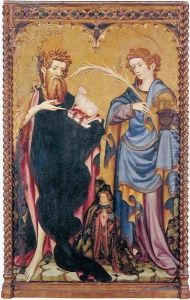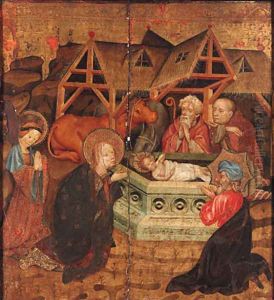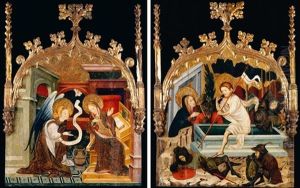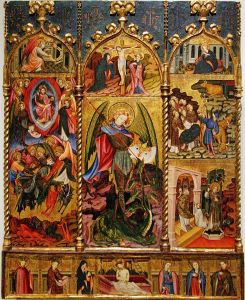Joan Mates Paintings
Joan Mates, also known as Johan Mates, was a prominent Catalan painter active during the International Gothic period, a phase in European art that spanned the late Middle Ages and the early Renaissance. Born in 1370, Mates's life and career were deeply intertwined with the cultural and artistic developments of his time, particularly in the region that now encompasses modern-day Catalonia, Spain.
Mates's work is characterized by its adherence to the stylistic elements of the International Gothic style, which is known for its elegant and elongated figures, vivid use of color, intricate detailing, and the blending of realism with idealized beauty. This style was prevalent across various European regions, reflecting a shared aesthetic sensibility that transcended regional artistic traditions. Mates contributed significantly to the development of this style within the Iberian Peninsula, and his works are considered important examples of late medieval Catalan painting.
Although specific details about Mates's life are scarce, historical records suggest that he was active in Barcelona, a major cultural and economic center in the Crown of Aragon during the late 14th and early 15th centuries. It is believed that he ran a workshop in the city, which would have been a bustling hub of artistic production, catering to the demands of the church, the nobility, and the burgeoning middle class for religious and secular art.
One of Joan Mates's most notable works is the altarpiece of Saint John, which showcases his mastery of the International Gothic style. His ability to convey complex religious narratives through detailed figurative compositions, along with his use of vibrant colors and gold leaf, exemplifies the aesthetic preferences of his time. Mates's work on this and other altarpieces demonstrates the important role that religious institutions played in the patronage of the arts during the medieval period.
Joan Mates passed away in 1431, leaving behind a legacy that has contributed to our understanding of Gothic art in Catalonia. His works, which have been preserved in various churches and museums, continue to be studied for their artistic and historical significance. Through his contributions to the International Gothic style, Mates played a crucial role in the rich tapestry of medieval European art, bridging the gap between the Middle Ages and the Renaissance in the Iberian context.



